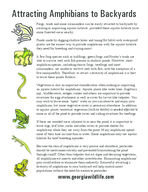Attracting Amphibians to Backyards
Frogs, toads and some salamanders can be easily attracted to backyards by creating or improving aquatic habitats, provided these aquatic habitats have some forested areas nearby.
Ponds made by digging shallow holes and lining the holes with waterproof plastic are the easiest way to provide amphibians with the aquatic habitats they need for breeding and staying moist.
A few frog species such as bullfrogs, green frogs and Fowler's toads are able to survive well with fish present in shallow ponds. However, most amphibian species, including chorus frogs, treefrogs and most salamanders, are unable to survive well with fish, with the exception of a few mosquitofish. Therefore, to attract a diversity of amphibians it is best to leave these ponds fishless.
Vegetation is also an important consideration when making or improving an aquatic habitat for amphibians. Aquatic plants like water lilies, Sagittaria spp., bladderworts, sedges, rushes and others are important to provide structures for egg attachment as well as cover for larvae like tadpoles. You may wish to leave some "open" water so you can observe and enjoy your amphibians, but some vegetative cover is necessary elsewhere. In addition to aquatic plants, terrestrial vegetation (such as shrubs) is needed adjacent to some or all of the pond to provide cover and calling structures for treefrogs.
If there are wooded areas adjacent to or near the pond, it is important to leave logs, leaf litter, rocks and other cover to provide shelter for amphibians while they are away from the pond. Many amphibians spend more of their time on land than in water. Some amphibians only use aquatic habitats for brief breeding episodes.
Because the skin of amphibians is very porous and absorbent, pesticides should be used conservatively and prevented from entering the pond through runoff. Other than tadpoles that eat algae and decaying vegetation, all amphibians eat insects and other invertebrates. Eliminating amphibians' prey could reduce or eliminate them indirectly. Successful attracting a diversity of amphibians to your backyard will help control insect populations without the need for excessive pesticides.
www.georgiawildlife.com
Amphibians Likely to Use Backyard Habitats in Georgia
Species
American Toad
Range in Georgia
Northern half of state
Level of fish tolerance
Able to tolerate fish
Fowler's Toad Southern Toad
Throughout state Southern half of state
Able to tolerate fish Able to tolerate fish
Cricket Frog Gray Treefrog
Statewide Statewide
Can only tolerate fish if there is abundant aquatic vegetation
Unable to tolerate fish
Green Treefrog
Squirrel Treefrog Spring Peeper Upland Chorus Frog
Statewide
Able to tolerate fish, although unlikely to breed in small pools
Southern two-thirds of state Unable to tolerate fish
Statewide
Unable to tolerate fish
Northern two-thirds of state Unable to tolerate fish
Southern Chorus Frog Southern half of state
Unable to tolerate fish
Eastern Narrowmouth Statewide
Unable to tolerate fish
Toad Bullfrog
Statewide
Able to tolerate fish
Green or Bronze Frog Statewide
Able to tolerate fish
Southern Leopard Nearly statewide
Able to tolerate fish
Frog Wood Frog Spotted Salamander
Northern third of state
Unable to tolerate fish
Northern two-thirds of state Unable to tolerate fish
Eastern Newt
Statewide
Can only tolerate fish if there is abundant aquatic vegetation
For more information on how to construct shallow ponds in your backyard, contact the Georgia Wildlife Federation at (770) 787-7887 or www.gwf.org.
For more information, contact the Georgia Department of Natural Resources, Wildlife Resources Division, Nongame Conservation Section, 116 Rum Creek Drive, Forsyth,
Georgia 31029 (478) 994-1438 www.georgiawildlife.com
